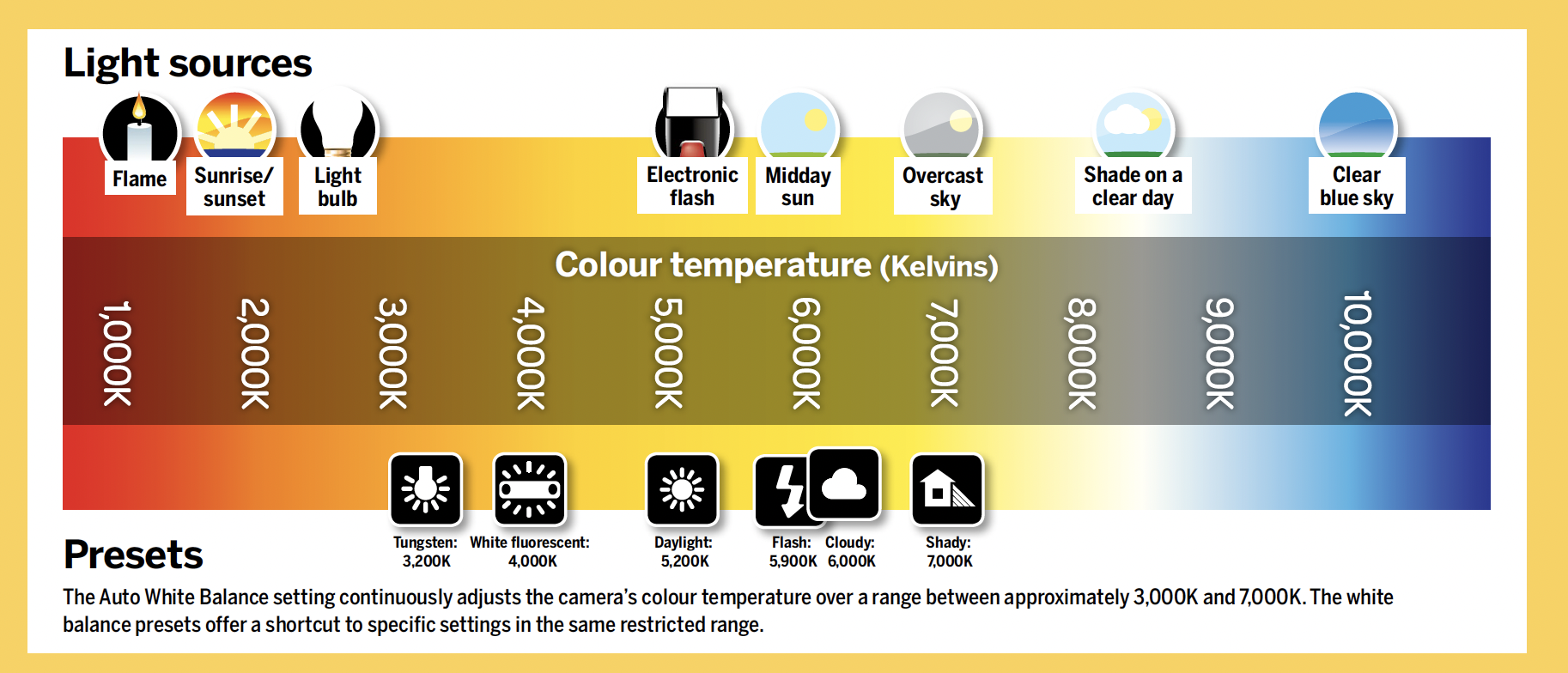Cheat sheet: What is white balance in photography?
What is white balance in photography? It enables you to record natural colors so your photos look right. This diagram will help you!

Newcomers and veterans often ask what is white balance in photography – it's a setting that's often taken for granted and neglected, even by experienced shooters.
In short, white balance in photography refers to the color temperature – how cool or warm the colors in your image are. And it's affected by the light sources in your image, from the yellowy-orange hues of artificial light to the blueish tones of LEDs and fluorescent illumination.
In addition to an automatic white balance setting, which will read your scene and select the best balance for you, most modern cameras also have a manual white balance control – and it's this that enables you to adjust the color temperature of images yourself.
Every light source varies in color temperature, which is measured in kelvin (K). At one end of the kelvin scale is the warm glow from a candle and at the other is the cool blue light seen in shadows on a sunny day. And multiple light sources can have conflicting temperatures!
So why adjust the white balance at all? Well, if you fine-tune this color temperature, you can record more accurate or natural colors in your scene.
What is white balance in photography
Since we're talking about "warm oranges" and "cool blues", you might be wondering why this setting is called white balance. The reason is, it enables you to ensure any that whites in the image are rendered as 'pure' white. For example, without a calibrated white balance, a sheet of white paper would appear orange when photographed under candlelight.
Really, white balance should probably be called 'light balance' – because the small icons you see when you scroll through your camera's white balance options all represent different lighting conditions.
The best camera deals, reviews, product advice, and unmissable photography news, direct to your inbox!
It's the job of the camera's white balance system to compensate for the color differences in the lighting, so that the colors in the scene look exactly as we would expect them.
Most cameras typically have a wide range of options for controlling the white balance to suit the color temperature of the light in the scene. However, your camera is set to automatic white balance (AWB) as standard – which will cleverly look after all this for you.
It's not infallible, however, which is why we sometimes need to take control manually – either selecting one of the preset options or by dialling in a custom white balance, which again is measured in kelvin.
If you find that your colors aren't quite right when you choose auto or the presets, refer to the diagrams above and try choosing your own kelvin setting – the difference can be pretty profound!
So what is the kelvin scale?
You'll often hear reds and yellows called 'warm' hues for convenience, since we think of fiery colours as hot, and high numbers often give reddish casts in-camera. In reality, the kelvin scale says differently.
Blue colours are the hottest (tungsten burns at a higher temperature than a candle flame and gives off a blue color) so these have a higher kelvin value. For this reason, if you want to remove a blue cast you’d match it by selecting a high-kelvin white balance (like 8,000K) for a neutral shot.
Alternatively, if there are lots of reds and yellows in the shot, you would select a low-kelvin number (like 3,000K) in-camera to balance these by introducing some blue. Remember to match the color of the light with a similar camera value to produce an image with no color bias.
White balance takeaways
- White balance is measured in kelvin (K)
- The "correct" white balance varies depending on the light source
- Daylight is typically 5500 – 6500K
- If you shoot in RAW format, you can tweak the white balance using photo editing software
Use the handy cheat sheet above to see this all for yourself. And make sure to keep us bookmarked for more great photography cheat sheets.
Read more
How to use a custom white balance
The best monitor calibrators
Photography tips
You might also like…
Find out more about how to use a custom white balance and keep us bookmarked for more great photography cheat sheets. And make sure that the colors on your display are correct with the best monitor calibrators!

Lauren is a writer, reviewer, and photographer with ten years of experience in the camera industry. She's the former Managing Editor of Digital Camera World, and previously served as Editor of Digital Photographer magazine, Technique editor for PhotoPlus: The Canon Magazine, and Deputy Editor of our sister publication, Digital Camera Magazine. An experienced journalist and freelance photographer, Lauren also has bylines at Tech Radar, Space.com, Canon Europe, PCGamesN, T3, Stuff, and British Airways' in-flight magazine. When she's not testing gear for DCW, she's probably in the kitchen testing yet another new curry recipe or walking in the Cotswolds with her Flat-coated Retriever.
- James ArtaiusEditor in Chief
You must confirm your public display name before commenting
Please logout and then login again, you will then be prompted to enter your display name.

